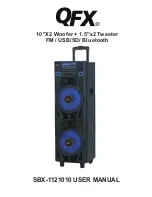
[GETTING STARTED AND PRECAUTIONARY NOTES]
For proper connection and therefore full enjoyment of your new Phase Technology speakers, we encourage you to read this owners’ manual
thoroughly, even if you are very familiar with installing speakers and home entertainment equipment.
Speaker placement is very subjective. Placement follows the guidelines for the developers of multi-channel home entertainment systems, yet
is also guided by personal preferences. The proper spacing, location and adjustment of front, rear and center-channel speakers as well as
subwoofers are critical for complete enjoyment of your new speakers. This manual covers these topics thoroughly.
Before connecting your new speakers or other system components, turn the system power off and unplug your amplifier to avoid any
possibility of damage from power surges or unbalanced loads before the system is properly connected.
Observe speaker polarity carefully! Every cable, speaker terminal and amplifier connection are clearly marked to show their positive (+) and
negative (-) polarities. For ideal system performance, always connect the positive side of the cable (marked with a stripe, color and /or other
indicator) to the positive terminals on your speakers and amplifier and the negative side of the cable to the negative terminals.
Amplifier selection is critical to your enjoyment of your new speakers. If you are considering upgrading your current component amplifier or
multi-function receiver, we suggest purchasing as much power as your budget can afford. It will always be preferable to have an affordable
high-powered model with fewer “bells and whistles” than a lower-powered model straining to operate near its power limits.
High volume settings that produce audible distortion – indicating an under-powered amplifier – could eventually damage your speakers and
your amplifier.
Begin and end listening sessions at low volume levels so you will not power up your system the next time with possibly harmful high voltages.
A damaging surge also could result if you change the input source (from FM tuner to CD player, for example) at high volume levels.
If you suspect that one channel of your amplifier has failed, have it repaired immediately by your dealer. Damage to your speakers could occur
if you switch between the good and defective channels.
[HOME THEATER SPEAKER PLACEMENT]
Today’s digital multi-channel home theater technology has elevated the art of “surround sound” to reproduce the movie theater experience
in your own home. Speaker requirements and placement are vitally important in reproducing these multi-media effects.
Two front speakers (left and right), two surround speakers (left and right), a center-channel speaker, and a subwoofer define the
minimum arrangement for modern multi-channel systems. Placement of speakers in your room will impact the final listening experience.
To position your speakers, there are some general guidelines that take room size, shape, and fixtures and furnishings into account. Use
the following illustrations as a general guide for speaker placement in a typical home theater system.
Front speakers should be placed 6-8 feet apart (or on the sides or your screen if your screen is wider) to fully separate the left and right
channels. Whether placed on speaker stands or on shelves, your speakers should be at or slightly above ear level.
Rear surround speakers also should be placed at or slightly above your listening position for the best reproduction of surround-sound
effects. Ideally, they should be facing into your favorite listening position from either side of the room
Center speaker placement should be, if possible, directly on top of or under your TV monitor or projection TV screen. Center speakers
should be placed in a horizontal orientation, directly below (or above) the center of your video screen. This correctly positions the
critical sound track information (usually dialogue) that filmmakers direct to the center channel. Phase Technology center speakers are
magnetically shielded so that they will not interfere with the performance of a video monitor (TV). The two center channel speakers in
the Premier Collection (PC-3.5 and PC-33.5) both include a table-top stand for placement on tables or shelves.
3


























